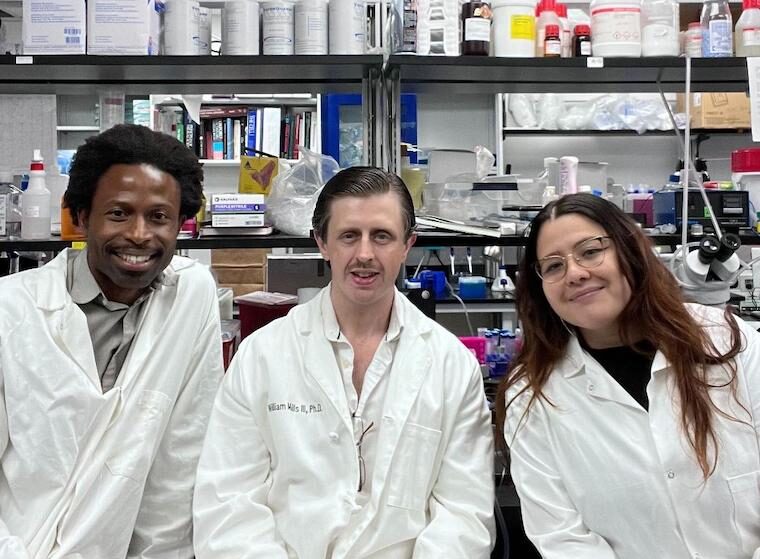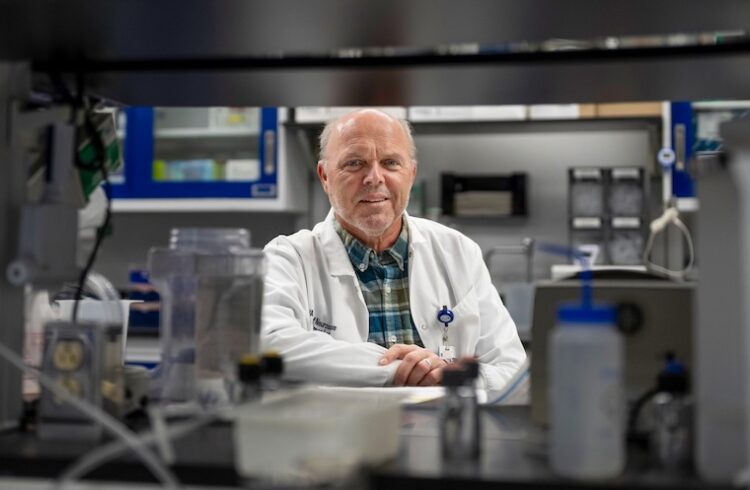
Researchers Ukpong Eyo, PhD (from left); William Mills III, PhD; and graduate student Aida Lopez have made a discovery that could let us boost blood flow to the brain to battle Alzheimer's.
New School of Medicine research suggests an unexpected way doctors may be able to improve blood flow to the brain to battle Alzheimer’s and other neurodegenerative diseases.
Scientists led by Ukpong B. Eyo, PhD, of UVA’s Department of Neuroscience, found that immune cells called microglia play an essential role in determining how well tiny capillaries deliver blood and essential nourishment to our brains. The scientists believe problems with these microglia could be contributing to failing brain health, and targeting them could help us prevent or reverse memory-stealing diseases caused or worsened by lack of adequate blood flow. This could include Alzheimer’s, vascular dementia and even some cases of Parkinson’s.
“For some time now, microglia have been suggested to play important roles in regulating vessel function. With this study, we have provided the most definitive evidence that they do regulate blood flow to the brain, specified the location of this function to the brain’s small vessels or capillaries and identified an enzyme that they use to do this,” said Eyo, of UVA’s Center for Brain Immunology and Glia (BIG Center) and the UVA Brain Institute. “Although microglia are dysfunctional in neurodegenerative diseases, our work now raises the possibility of improving blood flow deficits by targeting microglia.”
The Brain’s Big Demands
Our brains require a tremendous amount of sustenance. Even though they make up only 2% of our body weight, they use 20% of our total energy. To provide this, the brain is surrounded by a 400-mile-long network of blood vessels that branch most extensively into tiny capillaries. Proper function of these vessels and capillaries is essential to good brain health.
Scientists have known that problems with myeloid cells can contribute to excess carbon dioxide in the blood, robbing our brains of life-giving oxygen. But Eyo and his team wanted to understand more specifically which cells were responsible and to see what would happen if those cells weren’t working properly.
The researchers determined that microglia are responsible for ensuring proper capillary “tone,” which determines how well the tiny vessels can feed blood to the brain. Eliminating microglia significantly reduced the capillaries’ diameter and reduced their ability to transport blood, the scientists found. Restoring the microglia fixed this problem.
“The microglial enzyme identified in this study has been targeted heretofore in patients with Alzheimer’s disease, albeit with mixed results. Our study suggests that these therapeutics would have maximal benefit if prescribed according to the therapeutic window of microglia in Alzheimer’s – a focus in our ongoing research,” said UVA researcher William A. Mills III, PhD, the first author of a new scientific paper outlining the findings. “We have determined that all microglia are capable of regulating basal capillary tone as opposed to a subset of them, thus revealing their importance to meeting energy demands in the brain.”
The researchers say additional research will be needed to better understand the complex cellular communication network responsible for maintaining proper capillary function. But by better understanding how the immune system maintains capillary health, scientists may be able to boost blood flow to ensure the brain is properly nourished.
“Now that we have identified a novel role for microglia in blood vessel structure and function as well as a specific enzyme involved, we are poised to examine how this enzyme and microglial functions change, and to subsequently develop therapies to reduce these changes during neurodegenerative diseases broadly and in Alzhiemer’s disease especially,” Eyo said. “However, questions abound that our group will pursue – e.g. do the microglia regulate the small capillaries independently or in concert with other brain cells? When during development do microglia begin to play this role, and is this role also important in neurodevelopmental disorders where vascular function is also compromised? Can microglial replacement facilitate blood flow rejuvenation in neurodegenerative diseases? These are exciting questions we hope to answer in the near future.”
UVA recently established the Harrison Family Translational Research Center in Alzheimer’s and Neurodegenerative Diseases specifically to pioneer new treatments for Alzheimer’s and other brain disorders. The center is part of UVA’s Paul and Diane Manning Institute for Biotechnology. The institute will be housed in a four-story, 350,000-square-foot facility under construction at UVA’s Fontaine Research Park that is expected to bring hundreds and potentially thousands of jobs to Virginia as part of a new “ecosystem of innovation.”
Alzheimer's Findings Published
Eyo and his collaborators have published their findings in the scientific journal Nature Communications. The research team consisted of Mills III, Niesha A. Savory, Aida Oryza Lopez-Ortiz, Dennis H. Lentferink, Fernando González Ibáñez, Praise Agochi, Elina Rastegar, Arnav Gupta, Deetya Gupta, Arya Suram, Brant E. Isakson, Marie-ÈveTremblay and Eyo.
The research was supported by the National Institutes of Health’s National Institute of Neurological Disorders and Stroke, grants NS122782 and NS119243; the NIH’s National Heart, Lung and Blood Institute, grants HL007284, HL137112 and HL171997; the Owens Family Foundation; a UVA Brain Institute Postdoctoral Fellowship; and an American Heart Association Postdoctoral Fellowship, 25POST1376070.
To keep up with the latest medical research news from UVA, subscribe to the Making of Medicine blog.



